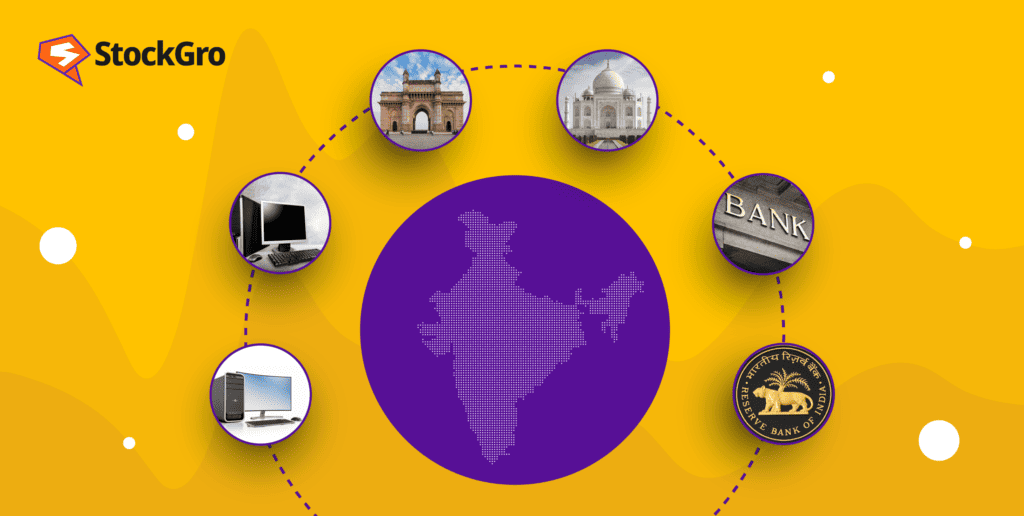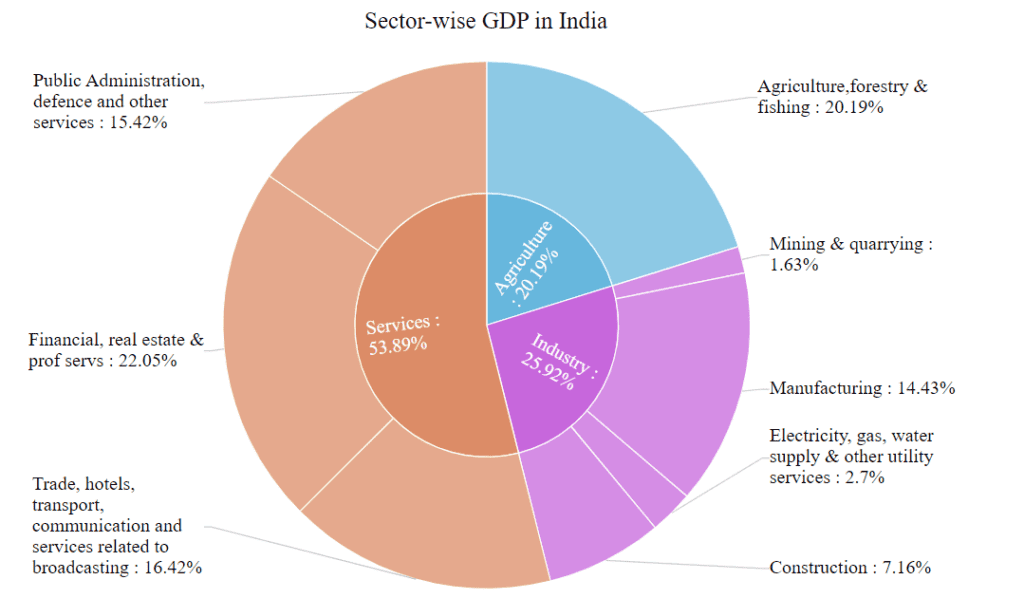
In the 77 years since India earned its independence, the service sector has contributed a lion’s share of 53% to the GDP of this country, highlighting the importance of the tertiary sector in the Indian economy.
Not only does the services sector account for the majority of India’s GDP, but it has additionally provided an enormous amount of employment, attracted substantial foreign investment, and increased exports.
The service sector has become the highest employment generator after increasing by 5-7% year over year in 2022.
Considering this scenario, let’s take a deep dive into the service sector in India and analyse the growth and challenges it has been facing, along with its prospects.
You may also like: A closer look at India’s latest Q4 GDP data: Key takeaways
What is the service sector in India?
Any industry that offers a range of services to the general public is considered a service sector. Simply put, the service sector is a medium of connection between the secondary and primary sectors.
Banking, real estate, information technology, media and entertainment, retail sales, hotels, financial services, and education are some of the service sector examples in India. These industries provide immense employment, including consulting, teaching, engineering, and retail sales.
Types of service sector in India
The services sector can be segmented into three primary categories.
Consumer services: Individual customers are going to be the target market for this kind of service. Consumer services are usually offered in exchange for a specific fee, where they create value by satisfying the requirements of the consumer. Some examples of consumer services are retail, hospitality, and entertainment.
Business services: Here, other companies or organisations are the target market for business services. Services like marketing, consulting, and information technology are two examples. Business services are usually offered under a contract or an agreement.
Public services: These services are for the broader community. Education and healthcare are two such examples of public services where the government or non-profit organisations create value by improving the safety, and quality of life of the general public.
The market today: Growth and challenges of the service sector in India
With 53% of India’s GDP at current prices coming from the services sector in FY22 (according to earlier estimates), the country’s services sector continues to be the primary driver of economic development.

The third quarter (2022–2023) saw a 6.5% rise in the services sector’s gross value added (GVA), accounting for nearly 84% of the overall GVA growth.
From Rs. 68.81 trillion in FY16 to Rs. 101.47 trillion in FY20, India’s services sector GVA grew at a CAGR of 11.43%. In terms of commerce, hotels, transportation, communication, and broadcasting services increased at a CAGR of 10.98% from FY16 to FY20, while financial, real estate, and professional services increased at a CAGR of 11.68%.
However, despite being a significant contributor to employment and economic development in India, the service industry faces several challenges.
Complexity of regulations: Businesses operating in the service industry may face difficulties due to complex and constantly evolving regulations.
Infrastructure limits: Limited logistics and transportation facilities might make it more challenging to provide services effectively.
Shortages of qualified labour: Although India generates a lot of graduates and professionals with advanced degrees, there may be a mismatch in the workforce’s skill set and what specific service industries want.
Using technological advances: Many other service sectors must catch up in embracing technology to improve effectiveness and viability, despite India’s significant developments in IT and software services. The modern global service landscape requires a digital shift.
Data privacy: Data security and privacy concerns have grown in importance in the digital era. Service providers have to make sure that consumer data is handled securely.
Also read: Textile industry in India – The foundation of fashionable clothing trends
Role of the public and private sector in the Indian economy
In India, the public sector is one of the economy’s primary forces. It provides possibilities and revenue for the public while charging reasonable prices for essential services that everyone needs.
From offering opportunities for employment and capital generation to promoting research and development and encouraging regional growth, the impact of the public sector is enormous on the Indian economy.
By 2023–2024, India’s economy may be worth USD 4 trillion, and by 2030, it might be worth USD 10 trillion. India’s growth and development strategy is focused on becoming the world’s third-largest economy; for that, the private sector will be heavily involved.
Private businesses are vital in promoting innovation, raising capital, creating employment, and raising competitiveness—all critical components of economic expansion.
With the economy opening up in 1991, India has seen spectacular growth, most of which can be credited to the private sector’s substantial involvement in the country’s development.
Top service companies in India
Below is a list of the top 5 IT-based companies among the service companies in India, ranked by market capitalisation (as of December 11, 2023)
| Name | Market cap (₹ cr) | Net profit (₹ cr) |
| Tata Consultancy Service | 1,328,949 | 42,303 |
| Infosys | 618,394.15 | 23,268.00 |
| HCL Technologies | 372,314.85 | 11,459.00 |
| Wipro Limited | 220,048.10 | 9,176.70 |
| LTIMindtree Ltd. | 169,608.56 | 4,256.30 |
Also read: The pharmaceutical industry in India and its contribution to the world
Future of India’s service sector
Compared to FY22’s 8.4% (YoY) growth, the services sector is predicted to expand by 9.1% in FY23. India’s services industry is expected to develop rapidly in the next few years due to continuing improvements in dipped trade barriers, easing FDI rules, and deregulation.
By 2025, India’s digital economy is predicted to grow to USD 1 trillion. India’s IT and business services industry is expected to surge by 8% by the end of 2023, reaching US$ 14.3 billion. On the other hand, the software services sector in India is expected to get close to $1 trillion in value by 2030.
Conclusion
Due to its particular strengths and competitive edge generated by knowledge-based services, India is a unique and expanding market on the global scene. With its potential to provide multi trillion-dollar opportunities, the industry could also encourage mutually beneficial development among all countries.

